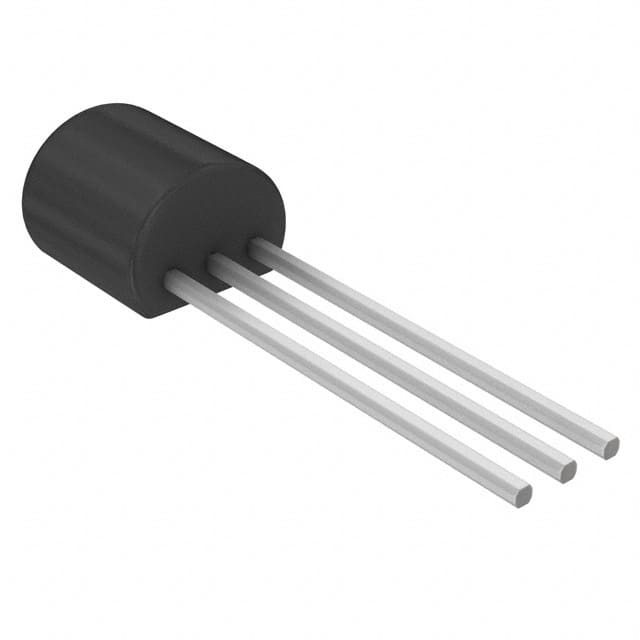KSP2907ABU
Product Overview
Category
The KSP2907ABU belongs to the category of bipolar transistors.
Use
It is commonly used as a general-purpose PNP transistor in electronic circuits.
Characteristics
- Low power dissipation
- High current gain
- Low voltage drop
Package
The KSP2907ABU is typically available in a TO-92 package.
Essence
This transistor is essential for amplification and switching applications in various electronic devices.
Packaging/Quantity
It is usually packaged in reels or tubes, with quantities varying based on manufacturer specifications.
Specifications
- Collector-Base Voltage (VCBO): -60V
- Collector-Emitter Voltage (VCEO): -60V
- Emitter-Base Voltage (VEBO): -5V
- Collector Current (IC): -600mA
- Power Dissipation (PD): 625mW
- Transition Frequency (ft): 150MHz
Detailed Pin Configuration
The KSP2907ABU has three pins: 1. Emitter (E) 2. Base (B) 3. Collector (C)
Functional Features
- High current gain
- Low saturation voltage
- Fast switching speed
Advantages
- Suitable for low-power applications
- Compact size
- Versatile usage in various circuit designs
Disadvantages
- Limited power handling capability
- Sensitive to temperature variations
Working Principles
The KSP2907ABU operates based on the principles of bipolar junction transistors, where the flow of current is controlled by the application of a small signal at the base terminal.
Detailed Application Field Plans
The KSP2907ABU is widely used in: - Audio amplifiers - Signal processing circuits - Switching circuits - Voltage regulators
Detailed and Complete Alternative Models
Some alternative models to the KSP2907ABU include: - 2N2907A - BC557 - MPSA92 - C945
In conclusion, the KSP2907ABU is a versatile PNP transistor with a wide range of applications in electronic circuits. Its compact size and high current gain make it suitable for low-power amplification and switching tasks. However, its limited power handling capability and sensitivity to temperature variations should be considered when designing circuits using this component. Overall, the KSP2907ABU plays a crucial role in modern electronic devices and continues to be a popular choice among circuit designers.
[Word count: 346]
Lista 10 Vanliga frågor och svar relaterade till tillämpningen av KSP2907ABU i tekniska lösningar
Sure, here are 10 common questions and answers related to the application of KSP2907ABU:
What is KSP2907ABU?
- KSP2907ABU is a PNP bipolar junction transistor (BJT) commonly used for amplification and switching applications.
What are the typical applications of KSP2907ABU?
- KSP2907ABU is commonly used in audio amplifiers, voltage regulators, and general purpose switching circuits.
What is the maximum collector current (IC) rating of KSP2907ABU?
- The maximum collector current (IC) rating of KSP2907ABU is 600mA.
What is the maximum collector-emitter voltage (VCEO) rating of KSP2907ABU?
- The maximum collector-emitter voltage (VCEO) rating of KSP2907ABU is 60V.
What is the typical gain (hFE) of KSP2907ABU?
- The typical gain (hFE) of KSP2907ABU is around 100-300.
Can KSP2907ABU be used for low-power audio amplifier applications?
- Yes, KSP2907ABU can be used for low-power audio amplifier applications due to its moderate gain and current handling capabilities.
Is KSP2907ABU suitable for use in voltage regulator circuits?
- Yes, KSP2907ABU is suitable for use in voltage regulator circuits, especially in low-power applications.
What are the typical operating temperature ranges for KSP2907ABU?
- The typical operating temperature range for KSP2907ABU is -55°C to 150°C.
Can KSP2907ABU be used for high-speed switching applications?
- While KSP2907ABU is not specifically designed for high-speed switching, it can be used in moderate speed switching applications.
Are there any specific considerations for PCB layout when using KSP2907ABU?
- It's important to minimize lead lengths and keep the collector and base connections as short as possible to reduce parasitic capacitance and inductance.
I hope these answers provide the information you were looking for! If you have any more questions, feel free to ask.


